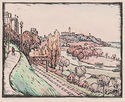
19th, 20th & 21st Century Fine Prints
707-546-7352 · fax 707-546-7924 · web: www.annexgalleries.com · email: artannex@aol.com
Maximillian Margius Fernekes Biography
Maximillian Margius Fernekes
American
1905-1984
Biography
Painter and printmaker Maximillian (Max) Margius Fernekes was born in Milwaukee, Wisconsin on July 7, 1905. The son of renowned architect Max Fernekes, Sr., he was drawn to design and art from an early age. Though he began his formal education in engineering at Marquette University, he soon abandoned that pursuit to study painting and printmaking full time, attending the Milwaukee State Teachers College (1928 – 1929) under the tutelage of artist Gustave Moeller.
Notable in Fernekes’ career was his desire to pursue art without unrelated part-time work, during arguably the most financially difficult period in the United States: the Great Depression. Along with his future wife and fellow artist Ava Avery, he would sell works in the square in front of St. John’s Cathedral, their paintings hung by clothespins.
Fernekes would eventually become known for his works depicting Wisconsin landscapes, architecture, and the daily life of its people. In the early 1930s he was hired by the Works Progress Administration to illustrate the book, “The Index for American Design”, a catalog of pre-1880s decorative arts of Wisconsin, written by Clarence F. Hornung. This set the stage for a future in art that related to his home state, and he was soon employed as an illustrator and interpretive artist for various Wisconsin organizations and publications, including the Milwaukie Journal; by 1942 he had sold them more than 200 drawings.
Ava and Max Fernekes moved to a farmhouse in Mineral Point in 1940, where they would remain for the rest of their lives, raising a family and starting what was the first art community of the area. His subject matter continued to celebrate the history and contemporary daily life of Wisconsin, though he was also known for his depictions of Mexico. In 1981 he was honored by the Milwaukie Art Commission for helping enrich the city’s cultural life through art.
Max Fernekes died ion November 28, 1984 at the winter home he maintained in Lampasas, Texas.

